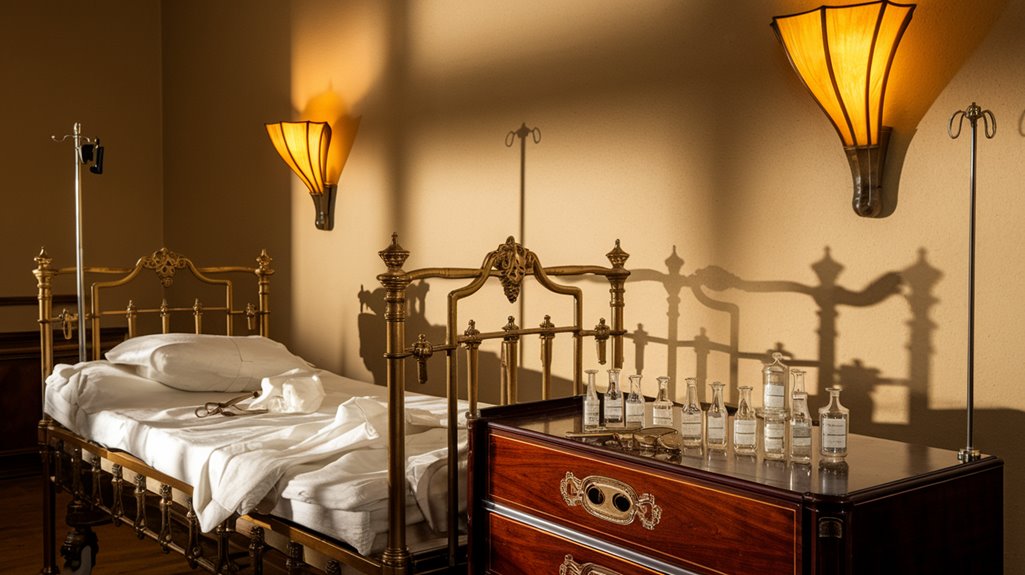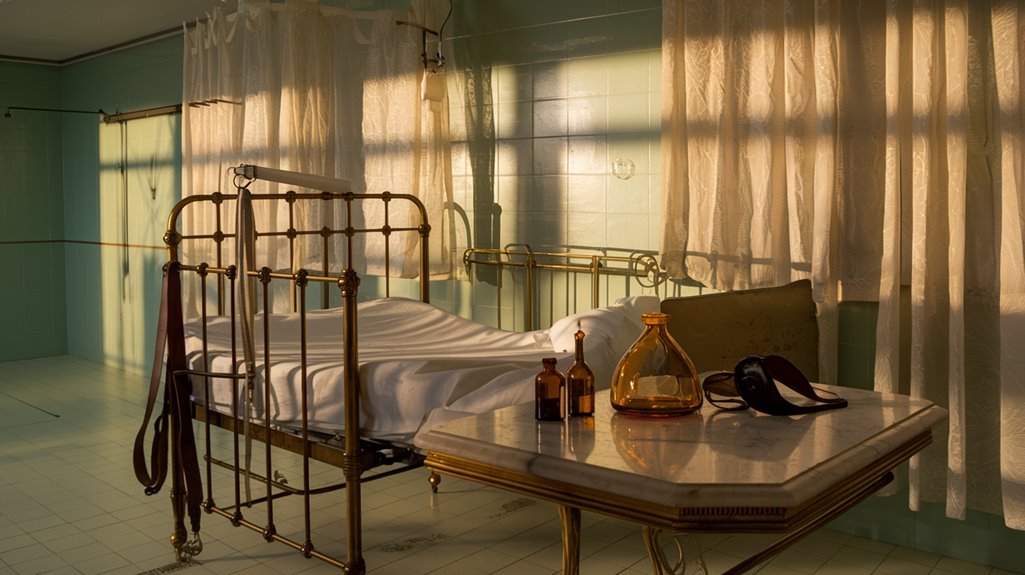Drugged Birth: The Twilight Sleep Controversy
You'd never guess that the quest for painless childbirth once led women to willingly embrace temporary insanity. In the early 1900s, a controversial drug cocktail promised mothers the ultimate gift: complete amnesia during labor. What you'll discover about Twilight Sleep isn't just a medical footnote—it's a complex story of women's rights, medical ethics, and the lengths people will go to avoid pain. The truth behind this practice might change how you think about modern childbirth altogether.
The Origins of Twilight Sleep in Early 20th Century Germany

While the early 1900s marked significant advancements in obstetric medicine, the development of twilight sleep emerged as a groundbreaking yet controversial approach to childbirth.
Initial experiments with the method encountered serious adverse effects, including breathing problems and delirium in patients.
This innovative approach used a combination of morphine and scopolamine to achieve a pain-free birth experience.
In this historical context, Austrian physician Richard von Steinbüchel first proposed using scopolamine combined with morphine for childbirth anesthesia in 1902.
The method gained momentum when German doctors Bernhardt Kronig and Karl Gauss presented their findings at Berlin's National Obstetrics Conference in 1906. Despite initial skepticism from their peers, they continued their research at the Women's Clinic of the State University of Baden.
Under Gauss' leadership, the Freiburg clinic became renowned for its impressive maternal and neonatal survival rates by 1907.
You'll find it interesting that this early success established twilight sleep as a promising option for wealthy German women seeking pain-free childbirth.
The Science Behind Morphine and Scopolamine
Understanding morphine and scopolamine's effects during twilight sleep reveals a complex interplay of risks and complications. These drugs can trigger severe neonatal effects, including depression and tachycardia in newborns, while also increasing their risk of asphyxia.
You'll find that the infant's exposure to these medications becomes particularly concerning during prolonged labor. Patients were often kept in dark padded rooms to minimize external stimuli during treatment. Modern medical guidelines indicate that scopolamine should be used in pregnancy only when benefits outweigh risks to the developing fetus.
The safety concerns surrounding twilight sleep are significant. You're dealing with medications that require precise dosing, yet historically, there's been insufficient knowledge about ideal amounts for individual patients.
If you administer these drugs incorrectly or too quickly, you're risking a potentially lethal overdose. The challenges extend beyond delivery, as scopolamine can pass through breast milk, potentially inhibiting lactation and affecting infant health.
These scientific realities highlight why twilight sleep became such a controversial practice.
From European Clinics to American Hospitals
As twilight sleep emerged in early 20th-century Germany, its journey from European clinics to American hospitals marked a significant shift in obstetric care.
You'll find that wealthy German women first flocked to Freiburg for this "painless babies" method, despite skepticism from medical professionals at the 1906 Berlin conference.
The practice caught America's attention when McClure's Magazine journalists Tracy and Leupp investigated German clinics in 1914. Their article transformed cultural perceptions of childbirth experiences, prompting American women to demand this new approach. The technique required sensory isolation methods, including darkened rooms and noise-reducing uniforms for medical staff.
From New York to San Francisco, hospitals rushed to establish twilight sleep units, with Chicago's Dr. Bertha Van Hoosen leading the charge.
This transformation wasn't just medical – it represented a shift from home births to hospital deliveries, forever changing how society viewed childbirth.
Medical Complications and Patient Safety Concerns
Despite its initial popularity, twilight sleep carried severe risks for both mothers and their infants. Patient experiences often included disorientation, screaming, and thrashing during labor, while the unpredictable effects of morphine and scopolamine could lead to lethal overdoses. Similar to modern concerns, the use of conscious sedation was considered riskier than full anesthesia.
You'd find mothers enduring prolonged labor and increased forceps usage, raising serious ethical implications about the practice's safety.
The dangers extended dramatically to newborns. Your baby could face suffocation risks, asphyxia, and morphine saturation that jeopardized their survival. Many infants developed neonatal abstinence syndrome as they experienced withdrawal from the drugs after birth.
The lack of proper dose control and the possibility of administering drugs during false labor pains made the situation even more precarious. These complications, combined with the potential for long-term developmental issues and withdrawal symptoms in infants, led physicians to question the method's value and seek safer alternatives.
The Suffragette Movement's Role in Twilight Sleep Advocacy

While the suffrage movement fought for women's voting rights, its tactics and ideals directly shaped the campaign for twilight sleep in early 20th-century America.
The suffragist activism behind twilight sleep gained momentum when the National Twilight Sleep Association formed in 1914, using familiar techniques like public lectures and media campaigns to challenge male-dominated medical practices.
You'll find that women's agency was central to the movement's message, with advocates like Hanna Rion Ver Beck and Mary Boyd emphasizing a woman's right to control her childbirth experience.
Through publications in McClure's Magazine, The New York Times, and The Ladies' Home Journal, the campaign united both feminist and anti-feminist supporters.
While their broader political views differed, these groups found common ground in fighting for women's access to painless childbirth. The movement's leaders viewed twilight sleep as a revolutionary solution to address both pain and maternal mortality during childbirth.
How Twilight Sleep Shaped Modern Obstetric Care
The campaign for twilight sleep did more than just mobilize women – it fundamentally changed the landscape of childbirth in America.
The practice emerged from German medical research and quickly gained traction through women's advocacy movements in the United States.
 scopolamine and morphine, this method aimed to eliminate birth memories while dulling pain.
scopolamine and morphine, this method aimed to eliminate birth memories while dulling pain.
You'll find its lasting impact on modern obstetric care through a dramatic childbirth evolution that shifted births from homes to hospitals.
The method's influence on pain management reshaped how we approach labor today, establishing three key transformations:
- Standardized drug interventions as the primary method of pain relief
- Elevated obstetricians' role while diminishing midwives' traditional practices
- Created a hospital-centered birth culture that persists today
Despite its eventual decline due to safety concerns, twilight sleep's legacy endures in contemporary obstetrics.
It's transformed birthing from a natural home-based event into a medicalized procedure, setting the foundation for today's hospital-based maternity care and pharmaceutical pain management approaches.










